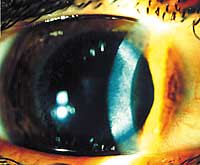Haze represents challenge to LASIK enhancement
Patients with significant haze after PRK do not fare as well with LASIK enhancement as those without haze, one study shows.
MADRID — LASIK appears to be a safe and effective method of enhancement for photorefractive keratectomy (PRK) in the majority of cases, though extra care must be taken in instances where patients ex perience significant post-PRK haze.
“LASIK enhancement ap pears to be more effective and predict able than PRK for correcting residual myopia after primary PRK. [However], patients with a haze value of grade 1 or more after primary PRK have a high probability of regression after LASIK enhancement and of generating a similar amount of haze with a concomitant loss of best-corrected visual acuity (BCVA),” wrote Carlos Lazaro, MD, and colleagues in Ophthalmology.
The study on which Dr. Lazaro reported was a retrospective, noncomparative case series of 36 eyes of 30 patients who underwent LASIK after primary PRK. A Schwind Multiscan excimer laser was used for the enhancement. Uncorrected visual acuity (UCVA), BCVA, refraction videokeratography and complication were determined before and after LASIK re-treatment. Follow-up was at least 12 months.
Patients and parameters
|
|
The study group was derived from patients initially treated at the Centro Oftalmologico REAL VISION with PRK over a 9-month period from January 1996 through September 1996. Dr. Lazaro retrospectively evaluated all eyes with myopic astigmatism up to –12 D mean spherical equivalent (MSE) that showed undercorrection or regression after surgery.
Re-treatment was performed after at least 12 months of follow-up for primary PRK and when refraction had stabilized. Stability was defined as a difference in refraction of 0.5 D or less when taken at 2-month intervals. Criteria for re-treatment were MSE of –0.5 D or more, UCVA of 20/40 or less and patient dissatisfaction with the visual result. Undercorrection was defined as an MSE of –1 D or more at the first-week postop visit. Regression was defined as 0.25 or more myopic shift between follow-up visits.
Before LASIK, 11.11% of eyes showed a UCVA of 20/40 or better. This increased to 94.44% 1 year after LASIK. None of the eyes achieved a UCVA of 20/25 or better before re-treatment. This rose to 72.22% after re-treatment with LASIK. None of the eyes had a spherical equivalent refraction of ±0.5 D prior to LASIK enhancement, and this rose to 77.78% after enhancement. Before LASIK, two of the eyes had significant haze. Haze remained in these two eyes and appeared in another eye following re-treatment with LASIK.
The mean haze value of the entire patient population before re-treatment was 0.39 ± 0.82 and 0.44 ± 0.89 after LASIK enhancement. The mean haze before treatment for the no-haze group was 0.06 ± 0.17 and remained constant at 12 months. Haze was never worse than grade 1 throughout follow-up.
The mean pretreatment haze in the haze group was 2.00 ± 0.89 and was 2.50 ± 0.54 1 year after LASIK enhancement. Two eyes showed a previous haze value of 3 that persisted at 12 months follow-up. One of these lost two lines of Snellen acuity. In a third eye, haze increased from grade 2 before LASIK to grade 3 after surgery, resulting in a loss of two lines of BCVA.
Myopic regression or undercorrections occur in approximately 10% to 20% of eyes after primary PRK, according to Dr. Lazaro’s report. His study showed that 12 months after LASIK enhancement, 94.44% of eyes had a UCVA of 20/40 or better and 72.22% of eyes had had a UCVA 20/25 or better.
“These results are better than those reported by Ozdamar et al, who found that 68.8% of eyes had a UCVA of 20/40 or better 6 months after LASIK re-treatment after PRK. Our results also seem better than those observed by authors considering PRK re-treatment,” Dr. Lazaro reported.
Haze effect
Significant differences were ob served in refraction during the follow-up period between the haze groups and the no-haze group, according to Dr. Lazaro. The MSE before LASIK in the no-haze group was –1.8 ± 0.78 D and was –4.91 ± 1.31 D in the haze group.
“These values are consistent with results observed by other authors and confirm the increased residual myopia before re-treatment in eyes with haze of grade 1 or more,” Dr. Lazaro reported. “In our study, an intended correction after 12 months of follow-up that was clearly better in the no-haze group than in the haze group was observed. In the no-haze group, 93.33% were within 0.5 D, whereas none were within 0.5 D in the haze group.”
Dr. Lazaro and colleagues concluded that if patients are to be assured the safest and most effective treatments possible, there is an obvious requirement for prospective studies comparing outcomes of different types of refractive procedures designed to treat patients with significant haze.
For Your Information:Reference:
- Carlos Lazaro, MD, can be reached at Centro Oftalmologico REAL VISION, Sta. Cruz de Marcenado 33, 28015 Madrid, Spain and at Hospital Provincial de Toledo, San Servando s/n, 45006 Toledo, Spain; (34) 91-542-6879; fax: (34) 91-542-6879; e-mail: lazaroft@teleline.es.
- Alfredo Castillo, MD, can be reached at Centro Oftalmologico REAL VISION, Sta. Cruz de Marcenado 33, 28015 Madrid, Spain and at Hospital Clinico San Carlos, Martin Lagos s/n, 28040 Madrid, Spain; (34) 91-542-6879; fax: (34) 91-542-6879.
- Lazaro C, Castillo A, et al. Laser in situ keratomileusis enhancement after photorefractive keratectomy. Ophthalmology. 2001;108:1423-1429.

